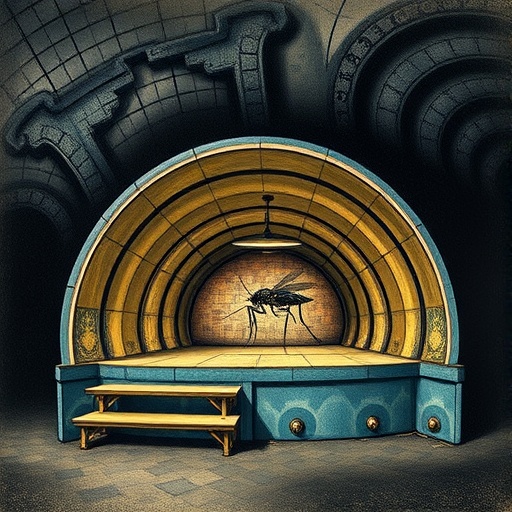In a groundbreaking genomic investigation, researchers have dismantled the long-standing myth surrounding the origin of the so-called “London Underground Mosquito,” a particular variant of the northern house mosquito, Culex pipiens. Contrary to popular belief that this form evolved relatively recently in the subterranean tunnels of modern northern European cities, new evidence points to an origin deeply rooted in ancient Mediterranean civilizations more than a millennium ago. This discovery not only reshapes our understanding of mosquito evolution in urban environments but also highlights the complex interplay between species adaptation and human societal development over thousands of years.
Culex pipiens, one of the most widespread and medically significant mosquito species, manifests in two distinct ecological and behavioral forms: Culex pipiens f. pipiens (commonly referred to simply as pipiens) and Culex pipiens f. molestus (molestus). The former typically targets avian hosts and thrives in open-air, seasonal habitats, whereas molestus exhibits a suite of adaptations enabling survival and reproduction in the confined, subterranean spaces of densely populated human settlements. These adaptations include the ability to mate in restricted environments, persist in cold temperatures throughout winter, preferentially bite humans, and uniquely, the capacity to oviposit without requiring a preceding blood meal.
The evolutionary history of molestus has long been the subject of scientific debate and popular speculation. One dominant hypothesis suggested rapid evolutionary divergence tied to the London Underground’s development during World War II, implying that modern human infrastructure could induce significant phenotypic and genomic shifts over mere decades. However, historical documentation and entomological records hint at molestus-like mosquito populations inhabiting European cellars and Mediterranean aboveground habitats centuries before the rise of the modern urban underground environment, casting doubt on this recent origin hypothesis.
To unravel the true origins and evolutionary trajectory of molestus, Yuki Haba and co-researchers undertook an extensive whole-genome sequencing project encompassing 357 specimens of Culex pipiens, drawn from a wide geographic range spanning Europe and North Africa, including both contemporary and historical samples. This comprehensive dataset allowed the team to employ advanced population genomics analytical techniques, examining patterns of genetic diversity, gene flow, and selection across time and space.
Their results decisively challenge the notion of a recent subterranean origin in northern European metro systems. Instead, the genomic data reveal that molestus populations diverged from their pipiens counterparts well over a thousand years ago in ancient aboveground settings within the Mediterranean and Near East regions. Notably, these locales coincide with the emergence of densely populated agricultural societies, such as those along the Nile River banks in Egypt, suggesting an ecological and anthropogenic context for molestus’s urban adaptation.
The exhibited traits of molestus — including mammalophily (preference for mammalian hosts), capacity for mating in confined spaces, and autogeny (laying eggs without blood meals) — were already extant in these ancient populations. This finding is crucial as it underscores that the preadaptations required for subterranean urban survival did not arise de novo in contemporary city infrastructure but were rather inherited from mosquitoes adapted to early human-altered environments. The persistence and refinement of these traits through subsequent periods highlight the layered nature of evolutionary adaptation.
Moreover, the investigation reveals that although these key traits were ancient, further evolutionary changes likely occurred following the colonization of underground urban habitats. This secondary wave of adaptation may have enhanced molestus’s fitness in the novel niches presented by modern subterranean infrastructure, such as optimized overwintering strategies and host-seeking behaviors aligned with densely packed human populations.
These findings hold profound implications for our understanding of urban ecology and vector biology. They suggest that successful urban colonizers like molestus are not solely the products of recent rapid evolution triggered by modern cityscapes but rather reflect a deep evolutionary legacy shaped by millennia of interaction with human environments. This insight complicates simplistic models of anthropogenic habitat adaptation and calls for nuanced investigation into how ancient ecological niches inform present-day disease vector dynamics.
In the context of public health, recognizing molestus’s ancient lineage and its long-standing association with human-altered environments enriches our comprehension of disease transmission pathways, particularly for viruses like West Nile virus, for which this mosquito is a potent vector. It compels vector control strategies to consider evolutionary history alongside contemporary ecological factors, potentially informing more effective management approaches.
Furthermore, this research illustrates the importance of integrating historical, ecological, and genomic perspectives to decode the evolutionary origins of urban-adapted species. The prospect that multiple independent colonization events shaped populations globally emphasizes that urban adaptation is a repeated evolutionary theme rather than a unique, singular event.
Jason Munshi-South and Ann Evankow, in their concurrent perspective piece, elaborate on the broader significance of these discoveries, emphasizing the interplay between ancient evolutionary preadaptations and modern ecological pressures in shaping urban fauna. Their commentary highlights the study’s contribution to the fields of evolutionary biology, urban ecology, and vector-borne disease research.
By bridging the temporal gap between ancient human civilizations and contemporary urban ecosystems, this research transforms our narrative of urban adaptation from one of rapid, recent change to a story of deep evolutionary continuity and complexity. It invites both scientists and the public to reconsider how long-term ecological processes and anthropogenic environmental modifications jointly shape the organisms that thrive alongside us in cities.
The revelation that molestus did not simply emerge from the London Underground’s dark tunnels but instead traces its lineage back to the banks of the ancient Nile underscores the intricate mosaic of evolutionary pathways that underlie urban biodiversity. This nuanced understanding challenges preconceived narratives, inspiring future research to explore the hidden histories embedded within the genomes of urban dwellers.
Subject of Research: Evolutionary genomics and urban adaptation of Culex pipiens mosquitoes
Article Title: Ancient origin of an urban underground mosquito
News Publication Date: 23-Oct-2025
Web References: http://dx.doi.org/10.1126/science.ady4515
References: Haba, Y., et al. (2025). Ancient origin of an urban underground mosquito. Science. DOI:10.1126/science.ady4515
Image Credits: Not specified
Keywords: Culex pipiens, mosquito evolution, urban adaptation, genomics, molestus, pipiens, vector-borne diseases, West Nile virus, ancient Mediterranean, genome sequencing, insect ecology, population genetics




